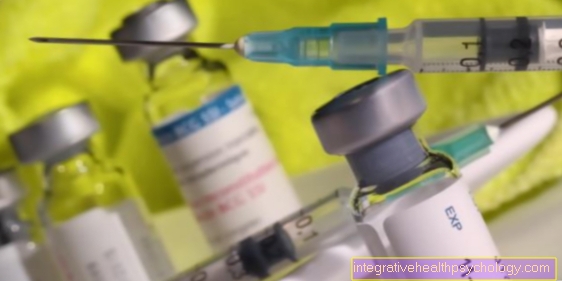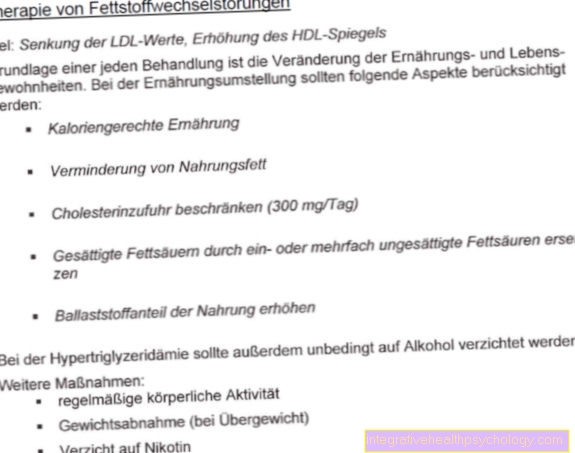Bronchitis in the baby
introduction

Bronchitis is an inflammation of the mucous membrane that lines the bronchi in the lungs. Bronchitis is therefore a disease of the respiratory tract and occurs particularly frequently in children and adolescents.
Bronchitis also occurs in babies, especially in the cold season, as the airways are attacked by the cold winter air and many viruses are circulating. Usually bronchitis does not last longer than two weeks, if the child develops bronchitis more often during the year or for a longer period of time, it is called chronic bronchitis.
The airways are structured as follows: After inhaling, the air enters the windpipe, which divides into the main bronchi in the chest. These pull into the lungs and branch out there in order to transport the air to the end of the finest and smallest bronchial branches. This is where the alveoli are located, which are surrounded by small blood vessels (capillaries). The blood flowing past absorbs the oxygen from the air we breathe and releases carbon dioxide back into the air we breathe out. The airways are lined with a mucous membrane, which is equipped with small, flexible cilia. These move continuously in the direction of the air that is exhaled, with the task of removing small dust particles or other foreign bodies with the constantly formed mucus from the bronchi. If this mucous membrane becomes inflamed, secretion builds up and breathing becomes difficult.
causes
In most cases, bronchitis is an infection with something called a respiratory virus. These viruses are particularly frequent in infecting the respiratory tract and causing colds such as bronchitis. As part of a cold (flu infection), bronchitis and inflammation of the windpipe (tracheo-bronchitis) often occur.
Bronchitis can also occur with other diseases and especially with classic childhood diseases such as measles or whooping cough (pertussis). In rarer cases, babies with a weakened immune system can develop an infection of the respiratory tract with fungi (for example: Candida albicans), which leads to what is known as thrush bronchitis.
Toxic gases or smoke can also irritate the mucous membranes of the bronchi and lead to inflammation. The causes of chronic bronchitis in babies are many. Often there is a congenital malformation of the respiratory tract or a congenital metabolic disease with increased susceptibility to infections, such as cystic fibrosis. But allergies or some enzyme deficiency disorders, such as the alpha-1 antitrypsin deficiency, can also trigger chronic bronchitis.
One of the most common causes of chronic bronchitis in babies or small children is damage to the mucous membrane caused by toxins in the air, and cigarette smoke in particular is very harmful.
Symptoms
What are the signs of bronchitis?
A bronchitis is divided into one depending on its course acute or one chronic Illness. A acute bronchitis in most cases is initially expressed by one dry (unproductive, non-slimy) Cough in baby. Only later does sputum usually appear, which can become slimy or even purulent. It can Shortness of breath or Rattling noises occur when breathing. Fever in baby usually only occurs in the early stages.
In the chronic bronchitis symptoms of acute bronchitis occur more frequently or for a long time. Especially in babies and toddlers, in the first three years of life, there is often a so-called obstructive, constricting bronchitis. This disease is also caused by viruses and can lead to shortness of breath in the baby, which can be very severe or even life-threatening. Typical is a whistling sound when exhaling, that sounds similar to an asthma patient (Wheezing). Because of their very small airways, babies quickly find it difficult to exhale when the bronchial mucosa becomes inflamed.
Bronchitis damages the lungs and is more prone to additional infections. Signs of a purulent bronchitisThat is caused by bacteria are, for example, purulent, cloudy, yellowish or greenish sputum. If the disease progresses further, it may cause a Pneumonia in the baby come, then you should definitely see a pediatrician.
Different forms of bronchitis in the baby
Obstructive and spastic bronchitis
Obstructive / spastic bronchitis is one Special form of acute bronchitis and can occur in both babies and toddlers. As with acute bronchitis, the pathogens are usually viruses, in particular Adeno- and RS viruses.
The pathogens cause an excessive reaction of the bronchial system Constriction of the bronchi, one also speaks of one Bronchospasm. There is an increased formation of secretions in the bronchi and a Swelling of the bronchial lining, which in interaction also results in a Bronchial constriction leads.
The symptoms that the baby shows are - similar to those in asthmatics - dry and unproductive cough. It can lead to shortness of breath, this is particularly evident in the baby violent breathing movements, of the upper body, in which it increases due to the strained breathing and the contraction of the abdominal muscles Indentations between the ribs can come, so that they can be seen when breathing.
Another sign of shortness of breath in the baby is the so-called Nostrils, the baby's nostrils move visibly with the inhalation and exhalation.
In very rare cases it can be caused by the decreased oxygenation of the blood to bluish discoloration of the mucous membranes, lips, hands and feet come. Oxygen deficiency that manifests itself in this way can be life-threatening.
Chronic bronchitis
Who has chronic bronchitis in the baby similar symptoms as the acute bronchitis (dry and unproductive cough), but comes more often again and lasts a lot much longer in their course.
It can have many different causes, all of which cause a certain amount of damage to the lungs, making them more susceptible to infections. The most common triggers are Toxins in the air we breathe, those who Damage the mucous membrane of the baby's bronchi can, the most prominent example is cigarette smoke.
Other causes can be congenital metabolic disorders which are consecutively associated with an increased susceptibility to germs, e.g. Cystic fibrosis / cystic fibrosis.
Furthermore can also Allergies, congenital malformations of the respiratory tract or Enzyme deficiency diseases cause chronic bronchitis.
How contagious is bronchitis in babies?
Bronchitis is one infectious disease, through a Droplet infection occurs, this means that the pathogen (especially Viruses) can be transmitted into the ambient air through coughing, sneezing, drooling or speaking of the sick person.
Studies have found that germs "hike" up to 8m in the air can. These pathogens are then inhaled by people who are still healthy. Whether bronchitis ultimately develops depends on the baby's immune system. Because babies still have one immature immune system have is one Contagion very likely.
Are particularly at risk of contagion / infection Premature Infantsis what babies call them before completion of the 37th week of pregnancy were born, infants younger than 3 months old and infants who have had heart or lung problems from birth. It is therefore very important to ensure that these infants do not come into contact with other sick children if possible.
How do I recognize bronchitis in babies?
A normal bronchitis - triggered by viruses - has in the beginning symptoms similar to a "normal" cold, how dry and unproductive cough, slightly elevated temperatures between 37.5 ° C and 38 ° C, it may be possible - typical for this disease - Rattling noises without listening to a stethoscope.
These noises are going through Secretion movements caused within the lungs. After a few days the symptoms may worsen, which means that the breathing of the baby faster and harder than is usual, so can that Heart beat faster, of the Cough becomes more productive (it will clear secretion coughed up).
There may be difficulty feeding the baby until he reaches the Refusal to eat. If the baby is also infected with a bacterium in addition to the virus, this is called one bacterial superinfection. This shows through increasing coughing attacks in the baby and the secretion it coughs up is much tougher than at the beginning and also has a yellowish discoloration. Furthermore, it can in the course of too fever and Deterioration in general condition come.
diagnosis

If a baby is showing signs of bronchitis, a doctor should be consulted. The diagnosis of bronchitis is usually based on listening to the lungs typical inhalation and exhalation noises possible.
If obstructive bronchitis is suspected, an x-ray may, in rare cases, be done to confirm the diagnosis. If you have chronic bronchitis, additional tests may be used to determine the exact cause of the disease. It can be useful, for example, an allergy test, one Sweat test, an x-ray, or even one endoscopic mirroring the airways (Bronchoscopy).
How long does bronchitis last in a baby? How contagious is the disease?
Bronchitis is a common respiratory disease in a baby. Up to twelve bronchitis cases a year are considered normal in young children. As the children get older, the infections should also become rarer, so a schoolchild should not develop bronchitis more than six times a year.
The Symptoms bronchitis usually last around ten to fourteen days on, in rarer ones Cases can also go up to four weeks stop. Some children have hypersensitive airways, which can result in a bronchial asthma can indicate. These children are particularly often affected by bronchitis. However, by refraining from smoking in the home and changing clothes regularly after smoking a cigarette, the sensitive baby lungs can be protected.
Bronchitis is one contagious disease. The risk of infection increases particularly in the winter months, as there are a particularly large number of viruses. The risk of infection is already increased if you are in the same room with a sick person, since the infection is about Droplet infection he follows. The pathogens spread with Sneeze, to cough or Speak sometimes over several meters through the air and are inhaled by the next person.
Babies and toddlers usually do not yet have a fully developed immune system. The body's own defenses are still weak, which is why they are particularly infected. The body's defense strength can be increased by a healthy eating and careful hygiene, especially frequent hand washing, should be encouraged.
therapy
What to do with baby bronchitis
Acute bronchitis is initially with Quiet and the supply of enough liquid treated. Are best suited warmth, unsweetened Teas so that the mucous membrane can regenerate and the mucus is loosened. Also can expectorant drugs given to relieve the child's discomfort.
So-called Cough remover or expectorants contain ingredients such as Acetylcysteinewhich are intended to change the structure of the mucus so that it becomes less tough and can be removed more easily. Ambroxol or Bromhexine support the production of a thin slime. A cough remover can be taken as a juice, capsule, or an effervescent tablet to dissolve.
Therapy with an antibiotic is only useful for baby bronchitis if the disease is through bacteria which is seldom the case. In obstructive bronchitis, the shortness of breath is caused by the constriction of the bronchi. To provide relief, other drugs can be used here that lead to an expansion of the small bronchi (for example beta-2 sympathomimetics). In the case of chronic bronchitis, it is paramount that the triggers of the disease are switched off or treated in order to alleviate the symptoms.
Bronchitis in the baby without a fever: About every third baby got bronchitis in the first year of his life. The symptoms can vary from case to case, usually it comes to flu-like symptoms with a slight fever. Particularly characteristic of the disease is a strong cough. Besides, the kids are limp and posted. A high temperature or fever does not necessarily have to occur with bronchitis. Instead it can too Loss of appetite and develop a runny or blocked nose. Even if no increased temperature or fever can be measured, the baby should be presented to a doctor if he has only drunk half the usual amount of milk in the last 24 hours, or if he has not had a wet diaper for six hours or more isDifficulty breathing, or the baby seems sleepy or lethargic.
Homeopathy for bronchitis
Homeopathic remedies like Belladonna, Actonium napellus, Bryonia Alba, Drosera, Hyoscyamus or Rumex can side effects such as the baby dry cough alleviate.
The cough should, however over 1 week hold long or the child fever get, refuse to eat, appear sleepy or even blue lips and / or get fingernails, it is not useful keep giving the baby globules.
In these cases please consult a doctor immediately, to exclude a bacterial superinfection or pneumonia, which should then be treated with an antibiotic.
When do you have to go to hospital with the baby?
First of all I have to say that very few babies develop severe bronchitis requiring hospitalization as an inpatient. Most bronchitis can do very well at home be treated. However, if your baby has any of the following symptoms, you should see a doctor with him:
If it all at once very sleepy works and is difficult to awaken
If it's in the past 24 hours less than half of his usual diet has consumed or consistently refused to do so
If there is any sign of Dehydration (Dehydration) shows this shows itself in the baby in dry diapers for a period of 6 hours or longer
If it Difficulty breathing has, this is shown in the baby as follows: If it visibly moves the nostrils when breathing in and out (Nostrils) when the abdominal muscles contract so much when breathing that you can see the ribs when the Fingernails or the Lips blue or if the baby starts to moan suddenly while breathing.
Additionally Fever over 38 ° C
When does the baby need an antibiotic?
There over 90% of bronchitis caused by viruses is an antibiotic in most cases not useful, as these only work against bacteria but not against viruses.
However, if there is one additional infection with a bacteriumwhich turns out to be severe in the course bacterial superinfection should show (with a high fever, refusal to eat and persistent cough), both a visit to the doctor and the intake of an antibiotic should be considered sensible.
Read more on the topic: Which antibiotics help with bronchitis?
Duration of bronchitis in the baby
After the baby has ingested the germ, it can up to one week take time for bronchitis to break out. Bronchitis should affect the baby no longer than 2 weeks last.
During this time the Symptomswhich can occur (cough, runny nose, fever, decreased general condition), subsided again be. Sometimes the cough can go on for a few days, but this should also be gone after 3 weeks at the latest. If this is not the case, take the baby to a pediatrician to rule out other causes.
prophylaxis
If the airways are irritated or mucous, care should be taken to ensure that the baby drinks a lot. The inclusion of enough liquid ensures that the mucus in the bronchi becomes more fluid and can drain away more easily. In addition, the child's environment should be adapted to the sensitive airways. It is important that there is no smoking in the vicinity of the baby, as cigarette smoke, in addition to the generally harmful effect, also irritates the mucous membranes. To keep the airways healthy, it shouldn't get too hot in heated rooms and on a pleasant humidity be respected. This can be achieved, for example, with the help of damp cloths over the heater and regular ventilation.
Also read: How contagious is bronchitis?























.jpg)





